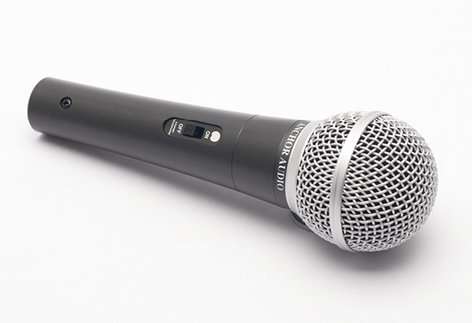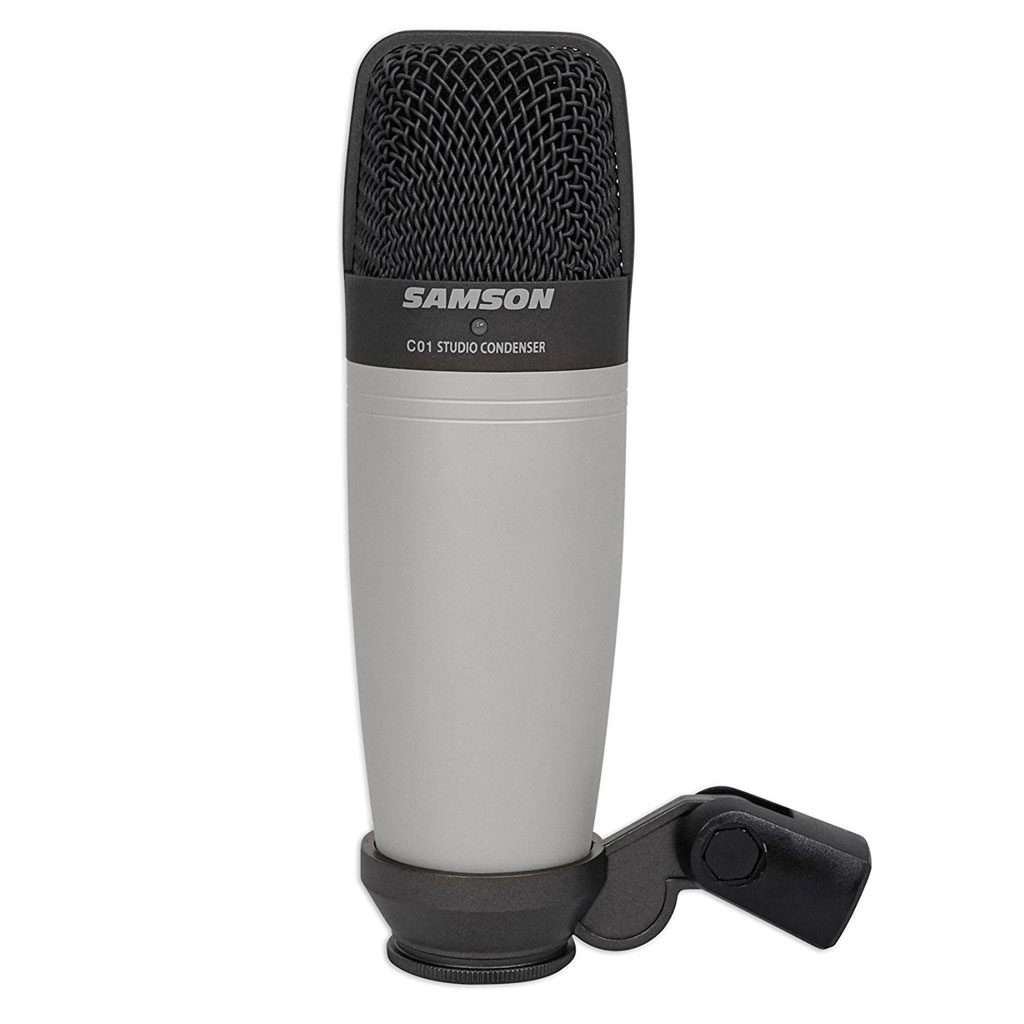You have probably done some research on what essential equipment you need in recording vocals and are probably wondering whether to use a dynamic or condenser microphone.
Recording vocals requires a low mass diaphragm to accurately capture sound. Condenser microphones have low mass diaphragms which makes them better suited for recording vocals compared to dynamic microphones.
It’s important that you understand what you’re trying to achieve when choosing microphones.
What are you trying to record? It goes beyond picking between a performance or studio microphone.
They are specific mics that are intended for:
- Instrument recording
- Drum recording
- Vocal recording
So make sure you know what needs to be done. In this post I’ll give you an insight into both dynamic and condenser mics so that you understand how they both work and what purpose they each try to achieve.
Dynamic Microphones

A dynamic microphone is a type of microphone that works through electromagnetism (electromagnetic induction to be exact),
what this essentially means is that it works using a wire coil and a magnet.
The sound that comes into the microphone is converted into an electric signal by means of electromagnetism.
How dynamic microphones work
Dynamic microphones (sometimes called Moving coil microphones) are traditionally designed like loudspeakers.
They have a coil inside of them that is surrounded by a magnet; this coil is attached to a membrane.
When you speak into the mic or when any other sounds enter the mic, the membrane and coil move backward and forward with the rhythm of the sound that is entering the mic.
This relative movement of the coil within its magnetic gap then induces an electric current in line with the incoming sound vibrations.
Most dynamic microphones don’t require an internal preamplifier; they have what is sometimes referred to as the presence effect, which is the response peak, often around 2.5 khz or so.
Dynamic microphone sound quality
Dynamic mics by design have a considerably lower output compared to condenser mics, this is not necessarily a bad thing because dynamic mics work best when they are capturing or recording loud sounds.
The low output is appropriate because the signal you’re capturing is already loud and strong.
Most audio engineers will go for condenser microphones when it comes to recording vocals, but this doesn’t necessarily mean that you need to write off dynamic microphones completely.
Dynamic microphones can also be used in certain “studio” situations, their primary role is for onstage performances but they can also be used for recording vocals in certain situations because they tend to pick up less room noise compared to condenser microphones.
Dynamic mics also tend to not pick up a lot of sibilance and they are not as harsh on the high end.
This is very helpful especially when you’re recording a high pitch vocalist, most likely a singer that has a brighter tone and a really present higher or upper range.
Tenor and soprano voices are normally known to be bright; therefore you definitely need to take precautions when recording the bright and piercing vocals.
You might need to back away from the high end and therefore you may need to use a dynamic microphone that will be able to probably handle this properly.
What are dynamic microphones used for?
Dynamic mics are commonly used for live performances or on-stage performances; they have the ability to handle loud, booming and powerful sounds so this makes them ideal for stage performances. They have lower output so this makes them perfect for loud sounds.
Dynamic mics are essentially tough and they don’t break easily, they can be dropped on stage and they’ll still work perfectly fine.
They are also cheaper compared to condenser mics; this makes them the go-to mic for live and on-stage performances.
Another use for dynamic mics is recording of instruments that have a lot of low and mid frequencies like synths and in some cases, vocals.
I wouldn’t advise you to record instruments that have a lot of low end, like kick and bass with a dynamic mic because the roll-off won’t be that great.
Nonetheless there are some special low end dynamic mics that can record bass and kicks properly and these types of mics often come with what is called a bass-bump that Is actually tailor made for low end instruments.
Does a dynamic microphone require power?
In a practical sense dynamic microphones do not need input power, they do generate power on their own when sound waves make the coil in the electromagnet move back and forth.
The vast majority of dynamic mics do not require power but they are some exceptions.
Ribbon mics for example, are a type of dynamic microphone, and they do require some power because they have active circuitry required to boost the output signal.
For more on dynamic mics and power, This article details all you need to know.
Condenser Microphones

Condenser mics sometimes called capacitor mics are microphones that are mainly used in recording studios due to their ability to record capture detail and accuracy.
How condenser microphones work
Think of a condenser mic as the “charged” approach for converting sound, the inner workings of a condenser mic in some sense are somewhat similar to a dynamic mic, in that it all starts with your voice or sound hitting the membrane causing it to vibrate.
However condenser mics are made up of a lightweight diaphragm suspended by a fixed plate, this thin diaphragm is made up of a material that can conduct electricity.
Hence a diaphragm essentially becomes a capacitor when it is charged with electric energy.
When the input sounds or vibrations come into the microphone, they hit the diaphragm and it moves, while the fixed plate stays stationary.
The difference in the space between the diaphragm and the fixed plate then creates the electric signal.
The lightweight thin diaphragm enables the condenser microphone to record and capture delicate sounds because it isn’t responsible for a heavy moving coil.
Condenser mics are delicate by design and are more susceptible to harsh environments.
Check out my picks of the best condenser microphones on the market
Condenser microphone sound quality
Condenser mics by design are great for studio work because they are built to capture delicate sounds like vocals.
They require phantom power which gives them high output sound.
They have extremely low mass and the thin nature of the diaphragm of condenser mics allows them to follow sound wave’s way more accurately as compared to dynamic mics.
Of all the mics, condenser microphones have the widest frequency response and they are highly sensitive and they offer lower noise compared to a dynamic microphone.
Keep in mind that condenser mics don’t work well for loud booming noises.
What are condenser microphones used for?
Condenser mics are sensitive mics and it is for this reason that they are used to capture vocals, acoustic guitars, acoustic pianos and even strings.
They are used to record these types of elements because they able to take accurate depictions of the nuances that are present within these instruments.
Condenser microphones are also ideal for those that do voiceover work, like in radio or podcasting.
Delicate touches are required in recording instruments hence the condenser mic is great for these types of situations.
I also personally use the condenser mic that is present in my studio to capture overhead recordings of drum kits.
Wit that said, check out this post detailing how you can make your mic quality better
Does a condenser microphone require power?
Yes condenser microphones require power; usually it comes in the form of phantom power.
Phantom power is the electric power transmitted through microphone cables that is required in order to operate a microphone.
Most studio condenser microphones require a power source to be able to work hence it is this power that is referred to as phantom power.
While it is true that phantom power is required, it is not uncommon for condenser mics to use a 9 volt battery. In the case of USB Condenser mics see this article
Related Articles You Might Find Interesting
What Instruments Can I Record With A Condenser Microphone?
Why Do Dynamic Microphones Need A Lot Of Gain?
Are condenser microphones good for choirs?
Additional helpful resources
Condenser vs Dynamic Microphones: When to Use Each – Careers In Music
Condenser vs Dynamic Microphones: When to Use Each – Pro Sound Web
One thought on “Which Is Better For Vocals, Dynamic Or Condenser Microphone?”